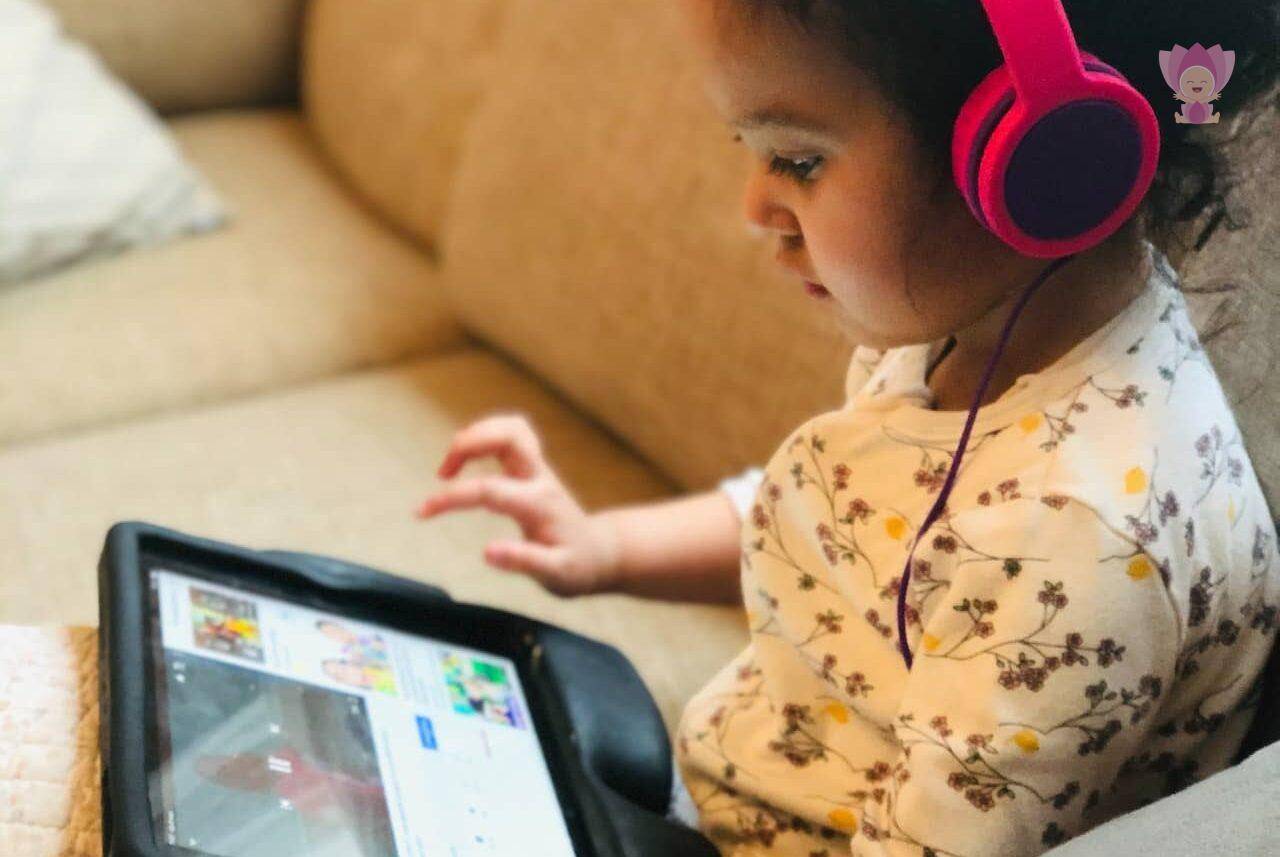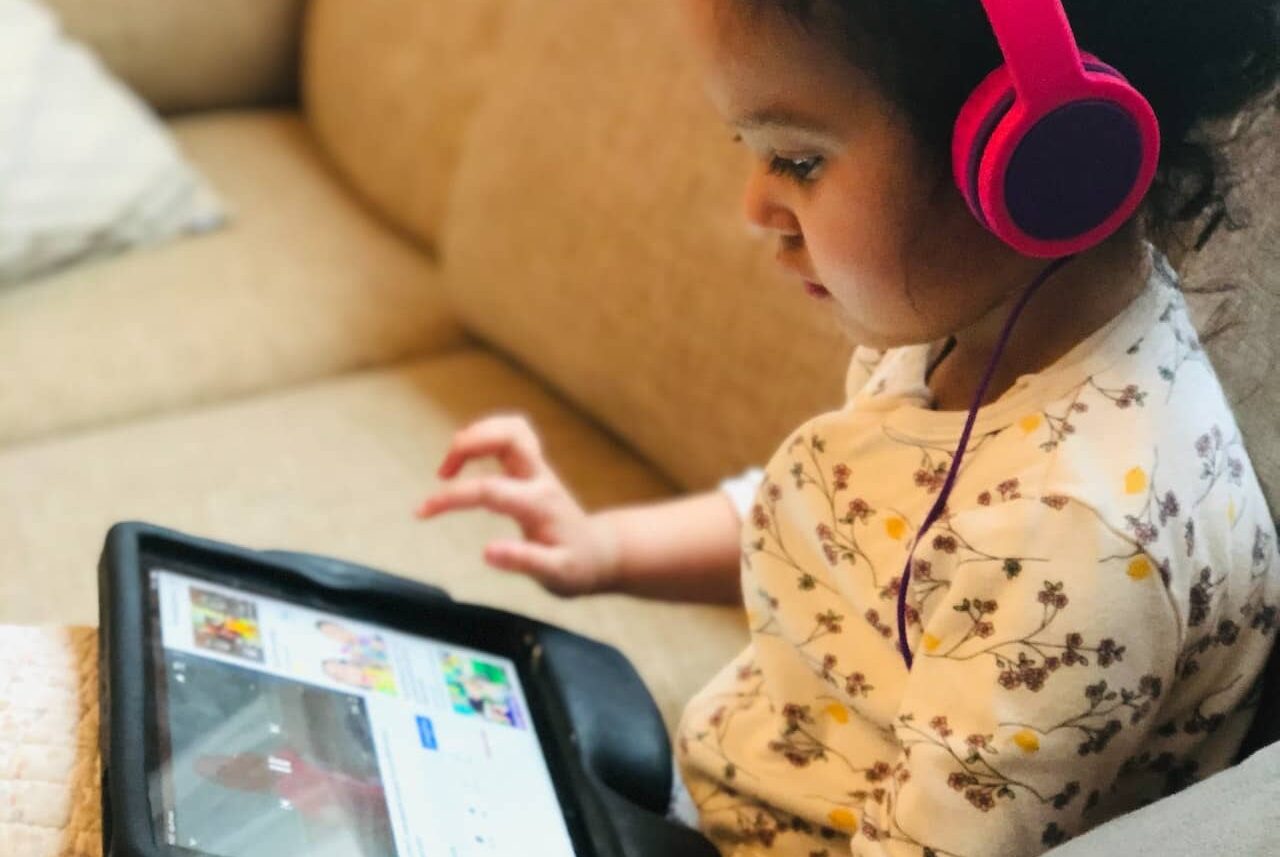Is screen time detrimental to a young child’s development? Maybe not

This post is part of our series on Digital Media and Children Under 3, published with collaboration from the journal, Infant Behavior and Development. The featured research appeared in a special issue that focused on how young children engage with technology and ways that parents can facilitate media engagement to promote positive development.
Key takeaways for caregivers
- Most studies on young children’s use of screens and unfavorable developmental outcomes have subtle, nuanced findings that prevent definitive conclusions that screen time directly causes developmental delays.
- If parents use screen media with their young child, they should interact with their babies, view content together, and watch programs that are educational (e.g., Public Broadcasting Service shows like Sesame Street and Daniel Tiger’s Neighborhood).
- Background media, particularly programming intended for older children, teenagers, and adults, should be turned off when not in use, especially during child’s play time.
- Screen media should not be used before bedtime.
- The entire family should practice and model appropriate levels of screen use and make time for activities that promote social, motor, language, and cognitive development.
Current guidelines for screen time with young children
Current American Academy of Pediatrics (AAP) guidelines recommend no screen time for children 18 months and younger (except caregiver-assisted video chatting), no screen use between 18 and 24 months without an adult, and no more than an hour of screen time after age two. However, nearly 70% of parents do not follow these guidelines and only 20% of parents are even aware that they exist. This is why I argued in my 2021 paper that the AAP should revise their guidelines to take into consideration the current technological landscape, updated research, and the realities of the home lives of families with children.
The most consistent benefits associated with a child’s screen time come from caregivers watching content with the child, a practice known as co-viewing.
Child screen time may not be as harmful as previously thought
Will regularly putting your young child in front of Sesame Street while you wash dishes or take a phone call be detrimental to your baby’s development? Probably not. Much of the research examining child development and screen media use has yielded mixed and nuanced findings.
It is difficult to determine cause and effect in these studies. For example, imagine a researcher finds an association between high rates of developmentally inappropriate screen time and non-optimal developmental outcomes. Is screen time directly causing developmental delays in this scenario?
Possibly, but it is more likely that several interacting factors contribute to both high rates of screen time and developmental delays (e.g., child characteristics like a “difficult” temperament or high levels of fussiness, families’ low income, parents’ education level, caregivers’ stress levels, parents’ mental health status).
Ethical and methodological limitations
Determining if screen time or other factors directly contribute to developmental outcomes is difficult given the ethical and methodological limitations of long-term studies. For example, researchers cannot ethically expose children to inappropriate amounts of screen time or unhealthy environments to measure their effects. Instead, they must measure existing risk factors in a child’s environments and examine the relations that emerge.
In addition, risk factors often occur together, making it difficult to isolate the specific effects of one particular factor, like excessive screen use. In light of research on children’s screen use and current trends in households’ technology use, many scholars who study this age period argue that the current AAP screen time guidelines for children may be too restrictive and unrealistic.

Photo: Ali Smith. Pexels.
Under certain circumstances, a child’s use of screens may be beneficial
Creators of educational programming (e.g., PBS) often consult with developmental experts when writing and producing content. As a result, certain techniques currently embedded in educational shows help young children learn. For example, pausing after asking a question, modeling simple tasks, highlighting important information to draw a child’s attention, and using familiar characters all increase a child’s ability to learn from screens.
In addition to these benefits to cognitive development, several recent studies have found that early use of touch screens may enhance a child’s physical development, particularly their fine motor skills (e.g., finger and hand coordination).
Benefits of co-viewing
The most consistent benefits associated with a child’s screen time come when caregivers watch content with their child, a practice known as co-viewing. Co-viewing creates opportunities for conversations about new situations and objects that families may not otherwise encounter.
This may have been especially useful early in the COVID-19 pandemic when caregivers were less likely to take their child out of the home setting. Co-viewing also creates more occasions to discuss emotions, sometimes even more so than traditional toys. Finally, co-viewing provides opportunities for caregivers to model and teach healthy media use habits, such as taking regular breaks from screen time to go outside, read books, or play with toys.
It is important to remember that children still need considerable amounts of face-to-face interactions to thrive.
Despite benefits, some screen time practices should be avoided
Screens cannot replace caregiver-child interactions. While screen time for children may not be as detrimental as once thought, it is important to remember that children still need considerable amounts of face-to-face interactions to thrive. Face-to-face interactions ensure that children learn social and emotional cues related to facial expressions, as well as accompanying language, skills children cannot learn from screens.
Children also need adequate opportunities to move around to support their physical development. As with older children and adults, sedentary behavior in children leads to a host of non-optimal outcomes, including a greater risk of obesity and delays in motor development. If families choose to let their child engage with screen media, they should ensure that child has adequate time to move around rather than being kept in a stationary, seated position.
Additionally, screen exposure disrupts sleep at all ages. Caregivers should be mindful to avoid screen time around sleep, particularly before and during bedtime routines.
Finally, there are no benefits associated with child viewing content intended for older children and adults. Occasionally watching adult-oriented programming (e.g., daily news programs) in the background will not have adverse outcomes for children. However, prolonged exposure to age-inappropriate programming can interrupt and distract children from beneficial learning activities, such as playing and co-reading. Long hours (2.5-3 hours/day) with age-inappropriate media and without a caregiver can result in non-optimal developmental outcomes.

Photo: Tuấn Kiệt Jr.. Pexels.
Recommendations for caregivers: Best practices for screen use with young children
Most families with children are not following current AAP guidelines for child media use. A solution to the disparity between AAP guidelines and actual child screen time habits may be to acknowledge a child’s screen media use, update and widely disseminate the AAP guidelines, and help families make decisions that take advantage of the known benefits and avoid the clear risks associated with advancing technology.
Meeting families where they are and making minor changes with regard to screen time habits is a more realistic goal given the current technological landscape than is trying to avoid screen time for children altogether.
I recommend the following best practices for screen time:
- If digital media use is part of the family’s lifestyle, be sure to allocate adequate time for sleep and for activities that develop motor, language, and cognitive skills.
- Engage with media content together; talk about what children are seeing, point out important features, and relate content to daily activities.
- Limit content to educational and prosocial programming (e.g., PBS shows like Sesame Street and Daniel Tiger’s Neighborhood)
- Turn off media when not in use, especially during a child’s play and reading time.
- Avoid watching adult-directed programming around children.
- Avoid using screens in the evening.
- Limit parents’ and siblings’ screen use to model appropriate levels of screen time and create adequate opportunities for children to engage socially with the family.
Continued research on child screen use is needed
Experts acknowledge the pros and cons of children’s screen use, and debate continues regarding its risks and benefits to child development. Researchers should consider the type of content children are being exposed to, the amount of parent involvement that accompanies a child’s screen viewing, and the context in which children are using screens to better determine the risks and benefits of using screens at this age.
Additionally, research needs to keep up with technological advances. For example, some content developers are teaming up with researchers to design developmentally appropriate screen media for children. These new approaches to content will need to be thoroughly evaluated, but they offer the possibility of age-appropriate content for children in the near future.
















Leave a comment